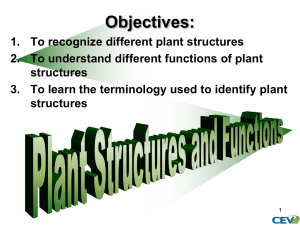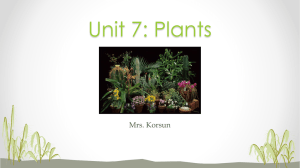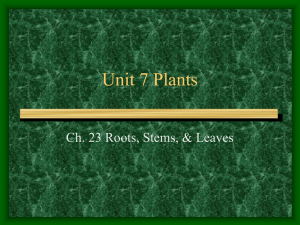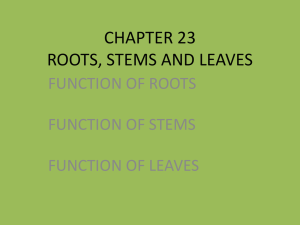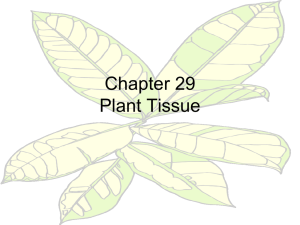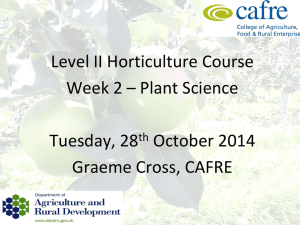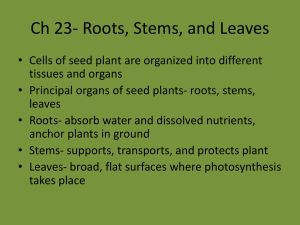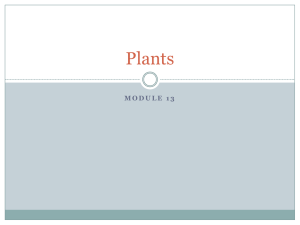Plants
advertisement
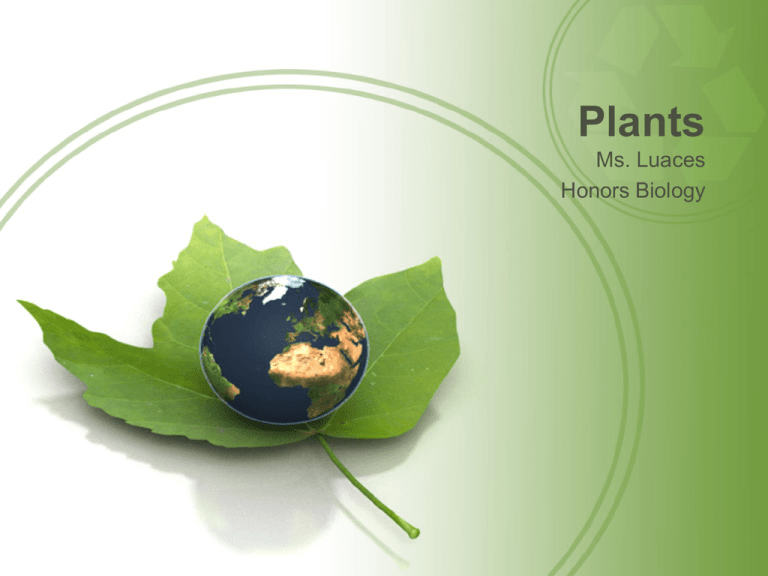
Plants Ms. Luaces Honors Biology 2.2 – Properties of Water • Water is a neutral molecule and found over 75% of Earth’s surface – However, water is polar (a molecule in which the charges are unevenly distributed) 2.2 – Properties of Water • Polar molecules like water can attract each other – known as hydrogen bonding – This accounts for many of waters special properties 2.2 – Properties of Water • Cohesion: attraction between molecules of the same substance – Why drops of water form beads and why there is such a thing as surface tension • Adhesion: attraction between molecules of different substances – Causes the capillary action that draws water out of roots up into a plants stems and leaves 2.2 Properties of Water • Water also has a high heat capacity – takes a large amount of heat to cause the molecules to move faster – This is why cells don’t overheat as they are carrying out the bodies processes – the water is drawing the heat out (sweat!) Chapter 22: Plants • Plants have adapted so well to many environments that they dominate much of the surface of the planet – Include trees, shrubs, mosses, and even green algae! 22.1 – Characteristics of Plants • Plants are: – – – – – Kingdom Plantae Multicellular Eukaryotes Have cell walls with cellulose Autotrophs (photosynthesis) 22.1 – Characteristics of Plants • The lives of plants center on the need for sunlight, gas exchange, water and minerals – Sunlight: required for photosynthesis so they’ve developed broad, flat leaves – Gas exchange: require carbon dioxide and have to let go of oxygen, so they’ve developed special parts to deal with this – Water and minerals: required for photosynthesis and survival, so they’ve evolved structures that limit water loss and increase the intake of water and nutrients upwards from the soil 22.1 – The History & Evolution of Plants • Ancestors of land plants were water-dwelling without leaves and roots: today’s algae – At first, algae was in Protista, but because they have cell walls and do photosynthesis, they are classified as plants 22.1 – The History & Evolution of Plants • Over time, the demands of life on land favored the evolution of plants more resistant to the drying rays of the sun, more capable of conserving water, and more capable of reproducing without water. 22.2 Seedless Plants • Algae: any photosynthetic eukaryote other than a land plant – – – – Mostly aquatic Absorb moisture and nutrients directly from their surroundings One of the first plants to evolve billions of years ago Can form colonies – how first plants probably arose 22.2 Mosses and other Bryophytes • Bryophytes: higher degree of cell specialization and one of the first plants to become established on land. • Characteristics: – Live in damp places with plenty of water – Lack vascular tissue (roots and stems) and lignin, and therefore cannot support a tall plant body – Include mosses, liverworts, and hornworts 22.2 Vascular Plants • Tracheophytes (vascular plants): have a transport system with true vascular (roots and stems) tissue • Characteristics: – Contain cells called tracheids (water conducting cells) – Contain xylem (carries water from the roots) and phloem (transports solutions of nutrients and carbs) 22.2 Vascular Plants • Vascular plants are split up into 2 categories: – Seed Plants: the majority of plants on earth – Seedless plants: ferns, mosses and horsetails Let’s Practice! • Study Workbook A Pgs. 17 #1-4 and Pgs. 253-255 SKIP #4-6 • Work with a buddy – one sheet of paper • Question AND Answer • You’ve got 40 minutes!! 22.3 Seed Plants • Each and every seed contains a living plant ready to sprout as soon as it encounters the proper conditions for growth • A seed is a plant embryo and a food supply, encased in a protective covering 22.3 The Importance of Seeds • Unlike mosses and ferns, the gametes of seed plants do not need standing water for fertilization • Adaptations that allow seed plants to reproduce without standing water include: – a reproductive process that takes place in cones or flowers – the transfer of sperm by pollination – the protection of embryos in seeds 22.3 Seed Plants Gymnosperms Angiosperms • Bear seeds directly on scales of cones • Male gametophyte is in pollen grain • Pollen is carried by wind • Flowering plants • Bear their seeds in flowers inside a layer of tissue to protect the seed • Male gametophyte also in pollen grain • Pollen is carried by animals 22.3 Seed Plants • Embryos can remain in dry conditions for weeks or even years because of the tough seed coat that surrounds and protects it 22.4 Flowering Plants • Angiosperms (flowering plants) are the most recent in evolution of plants – Contain ovaries, which surround and protect seeds – Attract animals such as bees to carry pollen to other flowers 22.4 Flowers & Fruits • Fruit contains one or more ovaries with seeds inside the walls – Helps to disperse the seeds, especially when eaten by an animal – Increase the range the plants inhabit (over hundreds of km) 22.4 Angiosperm Classification • Classified according to the number of seed leaves (cotyledons) in their embryos – One seed leaf – monocots – Two seed leaves – dicots – ** Recent classification has shown dicots go into a variety of different categories, and have been expanded – **Figure 22-22 is a good reference! 23.1 Specialized Tissues in Plants • Plants move materials, grow, repair themselves, and constantly respond to the environment. They do this with 3 principal organs that produce, store, and transport nutrients: – Roots – Stems – Leaves 23.1 Seed Plant Structure • Roots: – – – – – Anchor plants Absorb water and dissolved nutrients Transport these materials to the rest of the plant Store food Hold the plant upright 23.1 Seed Plant Structure • Stems: – Support the plant body – Transport nutrients – Serve as a defensive system that protects the plant against predators and disease 23.1 Seed Plant Structure • Leaves: – Main photosynthetic organ (absorbs sunlight and creates food) – Protect against water loss 23.1 Plant Tissue Systems • 3 main tissue systems: – Dermal: covers the plant like skin – Vascular: forms a system of pipe-like cells – Ground: produces and stores food 23.1 Plant Tissue Systems • Dermal Tissue: made of a single layer of cells called epidermis – Covered with a thick waxy layer (cuticle) which protects against water loss – The protective outer covering of a plant 23.1 Plant Tissue Systems • Vascular Tissue: supports the plant body and transports water and nutrients throughout the plant. Made up of 2 types of tissue: – Xylem: transports water (also known as tracheids) – Phloem: transports dissolved nutrients (also known as sieve tube elements) 23.1 Plant Tissue Systems • Ground Tissue: produces and stores sugars, and contributes to physical support of the plant – Edible portions of the plants – Composed of parenchyma cells and contain many chloroplasts for photosynthesis 23.1 Plant Tissue Systems • Even the oldest trees produce new leaves because of meristems: unspecialized cells in which mitosis produces new cells that are ready for differentiation – Only located at the tips of stems and roots (apical meristems) – Act like stem cells of animals – Gradually, the cells mature and specialize through a process called differentiation 23.2 Roots • Seeds put out their first root to draw water and nutrients from the soil – Adds length and surface area to take up water and nutrients – 2 types of root systems: Taproot & Fibrous 23.2 Types of Root Systems Taproot System Fibrous System • Primary root grows long and thick • Smaller branch roots from the main root • Ex: Oak, Dandelions • Many equally sized roots that grow separately from the base of the stem • No root is longer than another • Ex: Grasses 23.2 Anatomy of a Root • A mature root has an outside layer (epidermis), and also contains vascular tissue and a large area of ground tissue – Helps to transport water and minerals 23.2 Anatomy of a Root • Epidermis is involved in protection and absorption – Contains small projections called root hairs that help produce a large surface area for absorption 23.2 Anatomy of a Root • Ground Tissue moves water and minerals through the cortex and stores the products of photosynthesis (such as starch) – Also contains a layer called the endodermis which works closely with vascular tissue 23.2 Anatomy of a Root • Vascular Tissue helps absorb water and nutrients through the special channels xylem and phloem 23.2 Anatomy of a Root • Apical Meristem contains the root cap that protects the growing region of unspecialized cells 23.2 Root Functions • Roots support a plant, anchor it in the ground, store food, and absorb water and dissolved nutrients from the soil – Ingredients of the soil help define what plants can flourish there – In general, plants need large amounts of N, P, K, Mg, S, and Ca 23.2 Root Functions • Active transport (where the use of energy in the form of ATP is used to move materials across membranes) help to transport water by pressure from the outside into roots, up the stems and into the leaves – Root Pressure 23.3 Stems • There are above and underground (potatoes!) stems • Aboveground stems have several important functions: – Produce leaves, branches, and flowers – Hold leaves up to the sun – Transport substances throughout the plant 23.3 Stem Structure & Function • Stems are important water (xylem) and mineral (phloem) transport system • They also function in storage and aid in the process of photosynthesis 23.3 Stem Structure & Function • Stems contain all 3 tissue systems: – Dermal: thick layer of cell wall and waxy covering – Vascular: xylem and phloem – Ground: specialized mesophyll cells to carry out photosynthesis 23.3 Stem Structure & Function • Stems also contain nodes (attach leaves) and buds (apical meristems) 23.3 Growth of Stems • The growth of most plants isn’t precisely determined like our growth is • Adding length to the plant is called primary growth – Occurs in all seed plants and is a result of elongation of cells in the apical meristem 23.3 Growth of Stems • Adding thickness is known as secondary growth – Occurs mostly in pines and dicots, not in monocots – Allows plants to grow to great heights because the width supports the weight 23.3 Growth of Stems • In conifers and dicots, secondary growth takes place in the meristems called vascular cambium and cork cambium – Vascular: produces vascular tissue and increases thickness – Cork: produces outer covering 23.4 Leaves • Photosynthesis uses CO2 & H20 to produce sugar and oxygen The structure of a leaf is optimized to absorb light and carry out photosynthesis 23.4 Leaf Structure & Function • A leaf has a flat shape that helps maximize light absorption – the blade – Top and bottom surfaces are covered by epidermis (dermal tissue) that have thick outer walls that resist tearing and a waxy cuticle to waterproof 23.4 Leaf Structure & Function • The vascular tissue is made of xylem and phloem tissue bundled in leaf veins to transport water and nutrients 23.4 Leaf Structure & Function • Ground tissue makes up the area between leaf veins – known as mesophyll – Sugars produced here move to the leaf veins for transport in the ________? 23.4 Leaf Structure & Function • Stomata are small openings in the epidermis that allow CO2, H20 & 02 to diffuse in/out of the leaf – Transpiration is the loss of water through the leaves • Helps to keep it cool on hot days but can lead to water loss 23.4 Gas Exchange & Homeostasis • Photosynthesis – 02 Leaves CO2 • Plants use food (Cellular Respiration) – CO2 Leaves O2 • All through the stomata openings 23.4 Gas Exchange & Homeostasis • Plants maintain homeostasis by keeping their stomata open just enough to allow photosynthesis to take place but not so much that they lose excessive water – Guard cells surround the stomata and control opening/closing 23.4 Gas Exchange & Homeostasis • When there is a lot of water, guard cells will open the stomata – Vice versa when there’s little water – Typically, stomata are open during the day (why?) and closed at night (why?) 23.4 Gas Exchange & Homeostasis • Wilting results from the loss of water (therefore pressure) – When it wilts, the stomata will close (why?) 23.5 Transport in Plants • Remember that active transport and root pressure cause water to move from soil into plant roots – Major force of water transport is provided by transpiration 23.5 Water Transport • Capillary action (combines cohesion and adhesion forces) and transpiration work together to move water through the xylem tissues in the plant 23.5 Nutrient Transport • Phloem transport works through pressure-flow hypothesis – Active transport moves sugars through phloem – Water follows by osmosis Let’s Practice! • Study Workbook A 23.3 & 23.4 Pgs. 276280 • 23.3 #1-5, 7, 10-15 • 23.4 # 1-17, 19 • Work in pairs, one sheet of paper, answers only! Study Workbook A • Pg. 268 #9-13 • Pg. 284 ALL • Pg. 288-289 #17-27 – YES, you must draw the flower and label the parts! • UNTIL EVERYONE HAS FINISHED, WE CANNOT TAKE OUR TRIP!! Rooftop Garden • Sketch 2 of the plants and include their name at the top of the page. Include the following: – – – – How many nodes the plant has What kind of root system is it Leaf classification, arrangement, and shape If there are any flowers, what kinds of pollinators would be attracted? – If you had to name the plant yourself, what name would you come up with and why? (use Pg. 7 of your packet) Leaf Drawing Contest • If you had gone on the Magic School Bus, how would you have drawn the inside structure of a leaf? – Include in your sketch the following: the cuticle, ground tissue (including mesophyll cells), vascular system (both xylem and phloem), dermal tissue, and stomata. – Label all of the above parts – The best sketch that has identified ALL the parts above will get to choose from the coupon book Sample Sketch

